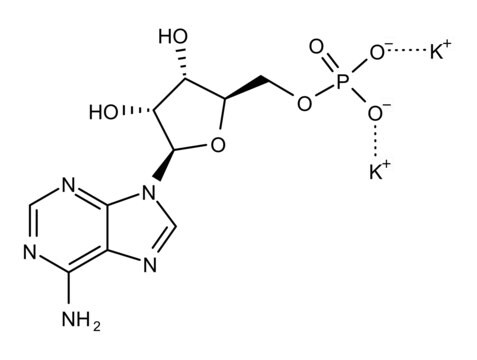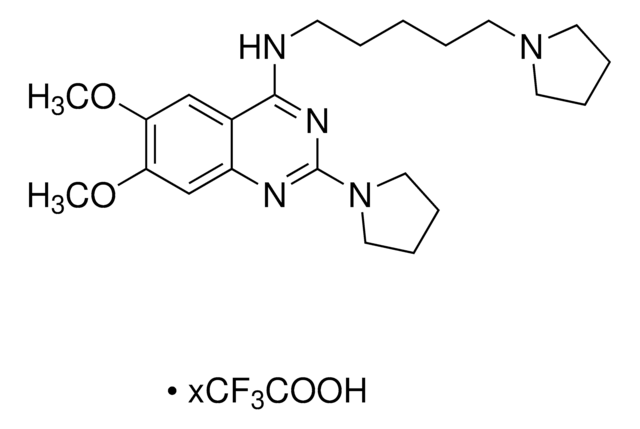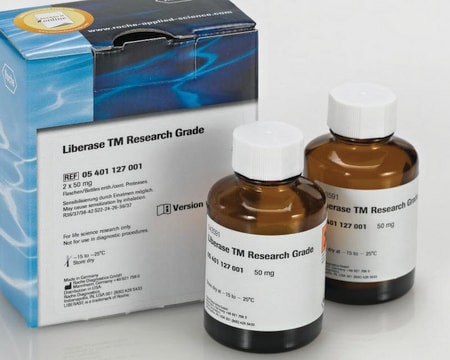SRP0195
PARP6 Active human
recombinant, expressed in baculovirus infected insect cells, ≥70% (SDS-PAGE)
Sinônimo(s):
MGC131971, Poly (ADP-ribose) Polymerase 6, pART17
Faça loginpara ver os preços organizacionais e de contrato
About This Item
Código UNSPSC:
12352200
NACRES:
NA.32
Produtos recomendados
fonte biológica
human
recombinante
expressed in baculovirus infected insect cells
Ensaio
≥70% (SDS-PAGE)
forma
aqueous solution
peso molecular
98 kDa
embalagem
pkg of 10 μg
concentração
>0.02 mg/mL
nº de adesão NCBI
nº de adesão UniProt
Condições de expedição
dry ice
temperatura de armazenamento
−70°C
Informações sobre genes
human ... PARP6(56965)
Descrição geral
PARP6 (poly(ADP-ribose) polymerase family member 6) gene is localized to human chromosome 15q23. It is a member of the family of multifunctional nuclear proteases known as PARPs, which contains 17 members and is further classified into three subtypes dependent on the catalytic domain structure. PARP6 is a type of mono(ADP-ribosyl) transferase on the basis that its catalytic domain has a significantly shorter nicotinamide-ribose-binding site than PARP1. This subfamily contains nine members including PARP6. PARP6 is composed of 630 residues and has a molecular weight of 71kDa.
Human PARP6 (GenBank Accession No. NM_020214), full length with N-terminal GST tag, MW = 98kDa, expressed in a Baculovirus infected Sf9 cell expression system.
Human PARP6 (GenBank Accession No. NM_020214), full length with N-terminal GST tag, MW = 98kDa, expressed in a Baculovirus infected Sf9 cell expression system.
Aplicação
Useful for the study of enzyme kinetics, screening inhibitors, and selectivity profiling.
Ações bioquímicas/fisiológicas
PARP6 (poly(ADP-ribose) polymerase family member 6) negatively controls cell cycle, as its ectopic expression in HeLa cells leads to suppression of cell growth. It functions as a tumor suppressor in CRC (colorectal cancer), and its expression is associated with good prognosis. The ectopic expression of PARP6 results in suppressed expression of the oncogene survivin. In CRC PAPR6 prevents colony formation, invasion, migration, and cell proliferation.
Definição da unidade
One unit of PARP incorporates 100 pmoles of poly(ADP) in 1 minute (room temperature) from NAD into acid-insoluble form.
forma física
Formulated in 25 mM Tris-HCl, pH 8.0, 100 mM NaCl, 0.05% Tween-20, 50% glycerol and 3 mM DTT.
Nota de preparo
Thaw on ice. Upon first thaw, briefly spin tube containing enzyme to recover full content of the tube. Aliquot enzyme into single use aliquots. Store remaining undiluted enzyme in aliquots at -70°C. Note: Enzyme is very sensitive to freeze/thaw cycles.
Certificados de análise (COA)
Busque Certificados de análise (COA) digitando o Número do Lote do produto. Os números de lote e remessa podem ser encontrados no rótulo de um produto após a palavra “Lot” ou “Batch”.
Já possui este produto?
Encontre a documentação dos produtos que você adquiriu recentemente na biblioteca de documentos.
Guangying Qi et al.
Oncotarget, 7(14), 18812-18824 (2016-03-05)
Poly (ADP-ribose) polymerases (PARPs) are enzymes that transfer ADP-ribose groups to target proteins and are involved in a variety of biological processes. PARP6 is a novel member, and our previous findings suggest that PARP6 may act as a tumor suppressor
Handan Tuncel et al.
International journal of oncology, 41(6), 2079-2086 (2012-10-09)
Poly(ADP-ribose) polymerase (PARP) is an enzyme that mediates post-translational modification of proteins. Seventeen known members of the PARP superfamily can
Nossa equipe de cientistas tem experiência em todas as áreas de pesquisa, incluindo Life Sciences, ciência de materiais, síntese química, cromatografia, química analítica e muitas outras.
Entre em contato com a assistência técnica




